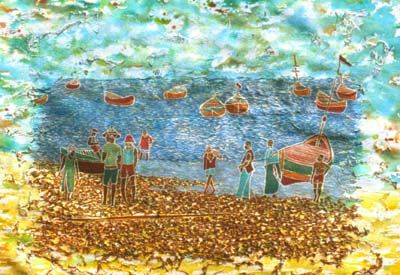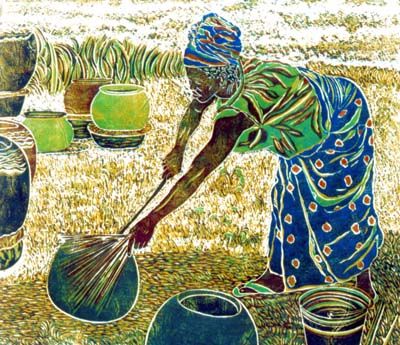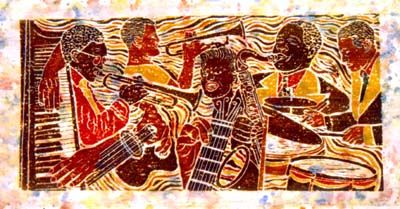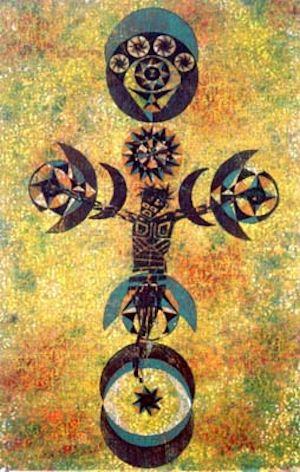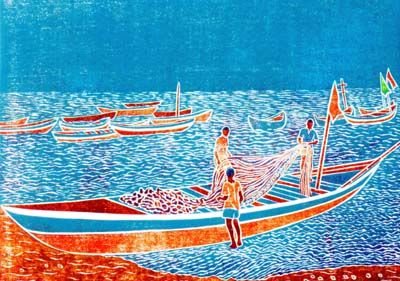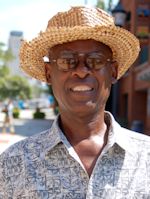|
KYSO Flash ™
Knock-Your-Socks-Off Art and Literature
|
|
|||
Five Woodblock Printsby Wayland House
Copyright © by Wayland House. All rights reserved.
Copyright © by Wayland House. All rights reserved.
Copyright © by Wayland House. All rights reserved.
Copyright © by Wayland House. All rights reserved.
Copyright © by Wayland House. All rights reserved. Editor’s Note by Clare MacQueenDuring the last week in September, as my sister and I roamed the grounds of the International Folk Festival in Fayetteville, North Carolina, she espied the compelling, colorful art of Wayland House; who, as we soon found out, has been painstakingly producing woodblock prints for four decades. Five of those eye-catching images are reproduced above. As House explains, he discovered many years ago through trial and error a technique of integrating woodblock printing techniques with watercolors, colored inks, collages, and cut-outs. The resulting art represents a unique and vivid approach to color. Through conversations and correspondence with House, I learned how he creates these prints, and what sets them apart from works created by other woodblock artists: The “Color Reduction Technique of Woodblock Printing” consists of printing layers of colors, one color at a time, starting with a light color, and printing from light to dark. The first color is printed with a predetermined edition size in mind, and a specific number of prints to be produced. The printmaker places paper atop the inked woodblock master plate, which is then hand rubbed, using a round flexible object. This transfers the image from the detailed, carved, wooden “Master Plate” onto the Asian printing paper. The artist carves out more and more of the woodblock surface between each color printing stage. This cycle is repeated: Print the color, then cut the plate and layer with ink in order to print the next layer of color. When the printing is complete, the woodblock “Master Plate” cannot be used again, which means the edition of prints is “limited.” For permanency, oil-based inks are used; and for its high absorbency rating, textured Asian printing paper made from plant fiber is preferred. The artist signs and numbers the final edition. This technique of executing prints one layer at a time, one print at a time, gives the finished print its tonal variations of colors that make House’s art unique: “Yellow as a source of light, tan and sepia depicting earth tones, blues and greens derived from nature, and oranges and reds that give the imagery a fiery contrast.” The white lines in the prints are projected from lines carved into the master plate, and these are designed to produce what he calls a “distinctive quality of movement, clarity, and expression” in his prints. While serving as a Peace Corps volunteer from 1957-1977 in Sierra Leone, Wayland House worked as an art instructor; and it’s not surprising that what he experienced of West African culture informs his art. When asked the stories behind the village scenes in this issue, he explained: ⚡ “Isatu the Potter” applies a glaze on the surface of a ceramic pot. Primarily a utilitarian art form whose main function involves storage of water, grain, smoked fish, and meat, ceramic pottery is generally produced by women; thus, this image symbolizes working women in West African culture. ⚡ “Three Fishermen” symbolizes working men. Those depicted in this print live and work along the coastline of the Atlantic Ocean. Together, they mend their nets after a full day of fishing. Their catch will be smoked in order to preserve it, and a portion will be loaded on vehicles to be sold in villages and towns throughout the country. Numerous coastal fishing areas provide this type of livelihood as well as food for local villagers’ consumption. ⚡ “Fishing Village” represents a typical West African beach scene, where villagers stroll along the Atlantic Ocean coastline on a Sunday afternoon, enjoying the warm and sunny weather. Wayland HouseIssue 2, Winter 2015
Painter and printmaker whose art has been exhibited since 1974 in government buildings, corporate offices, educational institutions, art galleries, art centers, and fine-arts festivals throughout the United States. The highlight of his career: appearance of his works on the NBC-TV series, A Different World, where a dozen of his woodblock prints adorned the women’s dormitory of the fictional Hillman College. More on the Web: By, About, and Beyond⚡ Artist’s BLOCK: Wood Prints Become Canvas for Wayland House’s Stories, excerpt in Questia from article by Denise Barnes in The Washington Times (25 September 1999) |
|
Site contains text, proprietary computer code, |
|
| ⚡ Many thanks for taking time to report broken links to: KYSOWebmaster [at] gmail [dot] com ⚡ | |
